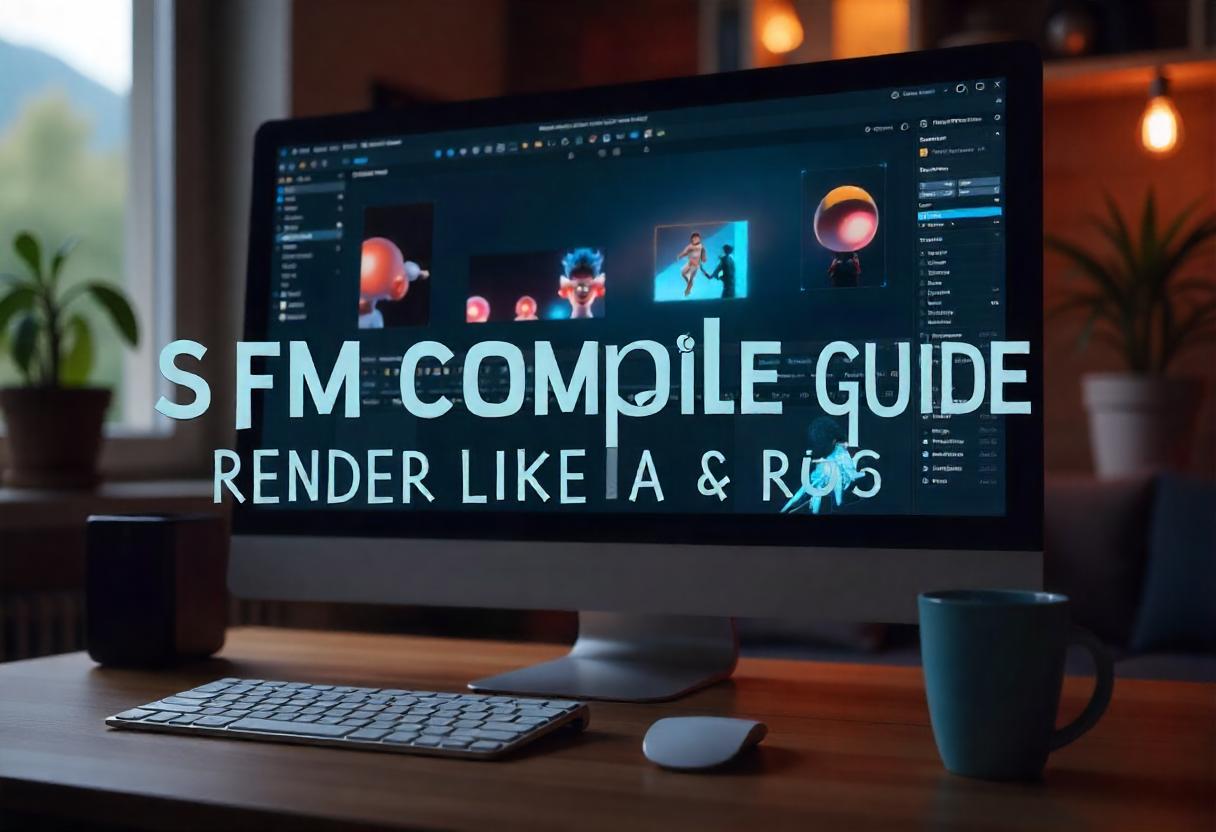SFM Compile Guide: Render Like a Pro
Through Source Filmmaker (SFM), animators living in the Valve environment create 3D animations. SFM Compile stands as a critical technical method for producing completed projects while rendering animations. The knowledge of SFM compile operations and practices enables amateur enthusiasts through professional animators to optimize their workflow for better animation outputs.
Introduction
The animation tool Source Filmmaker (SFM) originates from Valve as a game engine-based program. When Valve created SFM in-house for cinematography needs, they decided to make it available to the public, which led to its rapid adoption by animators because of its movie-quality features and user-friendly design.
Through Source Filmmaker, users gain access to animate characters while adjusting camera perspectives as well as changing lighting conditions by working inside a real-time game engine environment. The core advanced functionality within the tool appears during the SFM Compile operation. During compilation within SFM, you transform your scene into an end-product video that integrates every modification along with its features and components.
The SFM compile process requires users to understand frame sampling and compression methods alongside bit-rate management, although it seems straightforward to users. Inexperienced users make mistakes with these small but important factors, which create inferior outputs. SFM Compile allows professionals to reach studio-quality outcomes through their expertise.
The SFM Compile knowledge base delivers faster workflow completion together with superior video image definition and fluidity in final project delivery.
What Does SFM Compile Actually Mean?

SFM Compile functions as the operation that converts timeline animations into final video outcomes. The final product represents all the work you poured into keyframes together with adjustments to lighting and camera movements that you controlled and sound effects that you combined into a playable media format.
The SFM Compile system contains distinctive settings beyond basic rendering capabilities, which influence both system performance and end product quality. These include:
- Resolution settings (e.g., 720p, 1080p, 4K)
- Sampling rate and frame blending
- Codec selection (H.264, QuickTime, AVI, etc.)
- Audio sync and mixing
Understanding these parameters is essential. Using an incorrect codec creates both major quality problems and substantial changes to file dimensions. When users set improper resolution values, their video displays abnormal images, and the rendering duration lengthens.
The SFM software provides two compilation options through its native interface: users can select between “Image Sequence” and “Movie.” The first export process generates single frames that require third-party software for movie compilation. Direct movie file generation occurs through the second option. The two compile options function as separate solutions that match different requirements regarding control and post-production requirements.
SFM Compile demands artistic mastery as well as scientific precision because it requires mastering the relationship between speed, quality, and compatibility.
Preparing Your Scene Before Compilation
Thorough preparation of your scene must take place before starting SFM compile procedures. New animators tend to ignore the significant effect that pre-compilation cleanup and optimization play. The process of creating professional-grade animations demands longer preparation time than the compilation duration.
Key steps in preparation include:
- Trivial assets should be removed from your projects, including models, sounds, and particles. All this data occupies memory space, which is no longer rendered necessary.
- Verify that all lighting entities are properly configured without interferences.
- Multiple scene executions should occur to verify that all camera movements produce natural paths with no interruptions.
- Any simulated physics effects, including ragdolls and cloth physics, require final checks because their behavior becomes unpredictable during the render process.
A fundamental piece of advice states that you should make use of the Play in Timeline functionality to check how the animation will look after compilation. The identification of errors at this point saves you from performing extensive re-rendering tasks.
SFM Compile will operate more efficiently when users secure frame rate settings and position all essential sound files before beginning the process.
Choosing the Right Compilation Settings
Among all steps in SFM Compile workflow selection of appropriate settings stands as the crucial factor. The compilation options directly influence your project’s final output quality and size, along with compatibility specifications.
There are key settings that you need to establish.
- The quality benefits of using 4K resolution increase with having more system power available for processing the image.
- Your animation should work with 24 or 30 FPS, but you will need 60 FPS for smooth motion.
- The compile time duration grows longer when you use enhanced anti-aliasing because it removes jagged lines from the visual output.
- File compatibility during portability and future editing depends on selecting an appropriate compression type, such as H.264 for MP4 files.
- The accepted output formats should be chosen from .mov along with .avi or image sequence formats that work with your editing application.
Advanced users who want to reach cinematic looks should modify color correction LUTs and motion blur settings. After compilation, the tool ffmpeg enables users to apply additional compression methods and convert formats.
Users operating SFM Compile incorrectly will end up with an unpleasant video experience that displays low-quality and choppy footage. Authentication of these settings enables significant growth in your animation’s production quality.
Troubleshooting Common Compile Issues
Every animator encounters the annoying experience when an SFM compile fails during the animation process. The ability to diagnose general problems during video compilation will help prevent long periods of wasted work time.
Common Issues and Fixes:
- The absence of screen output displays as a black window primarily stems from the incorrect selection of camera settings. When working with SFM, ensure that the active camera is selected in the timeline.
- Regularly check the sampling rate because it affects audio desync. All audio files need conversion to the best compatible 44.1 kHz WAV format.
- When running out of memory, reduce either the resolution or shorten the video sequence. Closing background applications helps to free up the available RAM.
- Lower performance problems with video can be solved by disabling motion blur while also setting the anti-aliasing levels to minimum values.
- When dealing with long render times, users should transition from full movie output to image sequences instead. The sequence compiles more quickly and provides better post-production control because of its easy management.
A compile log or error output file enables you to discover specifically where coding problems occur. Such procedures work best for big programs that possess hidden errors that emerge only over time.
Learning to handle errors properly forms an essential skill when trying to become proficient in SFM Compile workflows.
Advanced Techniques for Optimizing Compilation

Examining advanced SFM compile techniques permits users to maximize workflow speed and produce better output results after understanding fundamental SFM compile methods.
Techniques Include:
- You should split background and foreground elements before rendering and combine them using After Effects or Blender.
- The setup process requires low-poly models to simplify scene building; therefore, users can exchange them for high-resolution models during compilation.
- Motion blur should only be enabled for crucial action scenes to decrease rendering duration yet preserve a movie-like sensation.
- The automation of shot compilation occurs through the implementation of Python scripts and SFM’s console commands during batch rendering.
- Custom Shaders: Utilize community-created shaders for enhanced lighting and material effects.
Visual improvements from these techniques make a workflow more efficient. Detailed mastery of these specific strategies allows animators to provide projects back to clients quickly with a high degree of professionalism.
Your investment in SFM Compile optimization will bring lasting results, especially when dealing with large-scale or business-led projects.
Integrating Post-Production Tools
Professionals utilizing SFM normally work with integrated external post-production software to enhance their work production.
Recommended Tools:
- Adobe Premiere Pro functions best for cutting operations along with transitions along with ending edits.
- Professional users select After Effects for the creation of visual effects together with color correction work as well as motion graphics production.
- DaVinci Resolve: Powerful color correction and audio sync capabilities.
- Users can employ ffmpeg as their command-line choice to re-encode files and resize them while changing their formats.
- The majority of creators export their files post-SFM Compile into uncompressed sequences before re-encoding these files using these tools for distribution purposes.
Through implementing this multiple-stage process, you get the complete authority to modify the appearance and feel properties of your animated work. Users create better YouTube videos, short films, and trailers through the combination of SFM with professional software packages.
Hardware Considerations for Faster Compilation

SFM Compile runs at a speed that depends primarily on the configuration of your equipment. The GPU acceleration used in SFM does not exclude CPU strain during compilation tasks along with memory resource usage peaks.
Ideal System Requirements:
- The NVIDIA GPU cards with numerous CUDA cores serve to deliver fast real-time previews in the system.
- CPU: Multi-core Intel or AMD Ryzen processor.
- Scenes requiring large memory space should utilize 32 GB of RAM, but 16 GB of RAM provides sufficient capacity.
- SSD storage systems deliver faster read/write operations that minimize project loading times as well as reduce cache loading delays.
The stability of power along with cooling performance remains vital since protracted compilation periods might cause overheating or performance throttling. A dedicated workstation built for SFM brings significant value to serious users who invest in its construction.
A top consideration for regular SFM Compile users need to be hardware optimization because it directly affects compile performance and speed.
Community Resources and Best Practices
The SFM community contains uncountable shared resources, including knowledge bases, tutorials, and plugins that enhance every step of SFM Compile.
Recommended Resources:
- Steam Community Forums
- Reddit’s /r/SFM
- YouTube channels like “LazyPurple” and “The Winglet”
- GitHub for user-made scripts and extensions
The best approaches for SFM mirror project version saves and consistent export naming systems while also organizing your file structure properly. Participating in your community enables you to follow the latest compile techniques as well as utility tools and repair methods.
When you actively participate in these groups, your SFM Compile development synchronizes with the evolving industry practices.
FAQs
What does SFM Compile do?
This software turns your animated content into a final format, either as a shareable video or an editable image sequence.
Why is my compiled video black?
The absence of camera selection and scene lighting setup likely explains why your compiled video displays black.
Which is better: Movie or Image Sequence?
Whenever you need a fast output, choose Movie, but choose Image Sequence for higher flexibility during editing.
Can I cancel a compile in progress?
You can stop a running SFM compile by either pressing Escape (Esc) or closing the render window.
Conclusion
Successfully using SFM Compile involves understanding all connections between scene arrangements and hardware devices with software data and export settings configurations.
The different production stages, starting from preparing the scene through error investigation and post-production tool integration, generate direct effects on your finished animation. The mastery of SFM Compile functionality enables you to extract maximum value from your projects to make your work shine in any genre, from fan films to meme videos and cinematic trailers.
SFM stands as a fundamental and powerful digital animation tool that digital animators should learn to compile efficiently to achieve maximum results.

